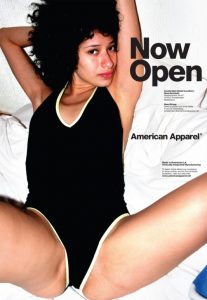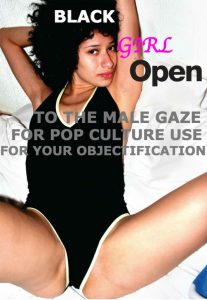Original Ad:

American Apparel, a North American retail store simultaneously promoted their products and a youthful, carefree “American Dream” through their ads. However, AA decided to take on a more risqué image – suddenly the promotion of the youthful “American Dream” became the promotion of borderline pornographic and hypersexualized images of young girls.
This ad promotes an ideal of how girls, specifically young black girls, should look and behave rather than the brand itself. While one may argue that AA’s ad is a new form of empowerment for women to embrace their sexuality, I believe all this ad does is feed the male gaze. AA is sending out anything but a feminist message for women to reclaim their bodies, rather the ad is claiming the model’s body as merely a muse for the entertainment of men and media. The obvious sexual innuendo of “open” is clear with the model’s legs spread unnecessarily far apart, exposing her groin to the eyes of the public. The position of her laying spread out on the bed makes her seem like a display, as if the ad was selling her, not the body suit or the brand.
While there is no doubt that popular culture capitalizes on selling women as objects and AA does not discriminate in race when it comes to pornographic shots of women, the use of a young black model raises a series of red flags. Media (i.e. music videos) objectifies and uses black women as accessories – in many cases they are seen displaying their rear ends and/or flashing their breasts. Pop culture loves black women, but only for the use of their bodies. The provocative nature of the ad paired with the vulnerable expression of the model further perpetrates the idea that black women are sexy only when they are submissive. It sustains the rape culture against black women as it tells men that they want to be forced into submission; that the obvious discomfort on the model’s face can be ignored. When I see this ad, I see a young black girl objectified for a not-so-creative sexual innuendo, not a model for a clothing store.
Jammed Ad:

The jammed ad removes the information about AA’s new store and the brand’s name and instead, shines a light on how the ad objectifies a young black woman. The added text highlights how AA’s ad does more than sexualize the model, but rather it also degrades her to being a second class citizen – one who exists merely to serve as an object to the male gaze and to play as a prop/accessory in media.
The removal of the word “now” and the altered text “black girl open to the male gaze, for pop culture use, for your objectification,” brings forth the issue of how it is not recent news that black women have to face adversities daily simply for the race they were born into. This is because media’s constant exploitation of black women (i.e. using them as sexual props in music videos) has always been justified and normalized – as if black women should just be grateful for the opportunity to be featured on a platform largely dominated by men and their fair skinned female counterparts. The model’s facial expression of discomfort and vulnerability has been left unaltered, emphasizing the fact that black women have been forced into a “lessor” category of human for their natural skin tone, gender, and curvaceous bodies.
It is my hope that the jammed ad will spark conversation on how media’s excessive exploitation of black women deepens the many problems they face. The aspect of a hypersexualized black girl strengthens the idea and expectation of black women to serve as sexy, submissive creatures. Furthermore, the promotion of black women as sexualized objects paired with a subservient pose/expression compounds the societal epidemic of black women being more likely to fall victims to continuous domestic/sexual violence. Sadly, the normalization of degrading black women has stripped them of a voice and power in society, providing an incentive for men to continue to view them as submissive objects.
The goal of my jammed piece ultimately underlines the disturbing fact that AA’s ad barely fulfils its purpose as an ad for a new store, but largely contributes to the objectification, degradation, and rape culture of black women.